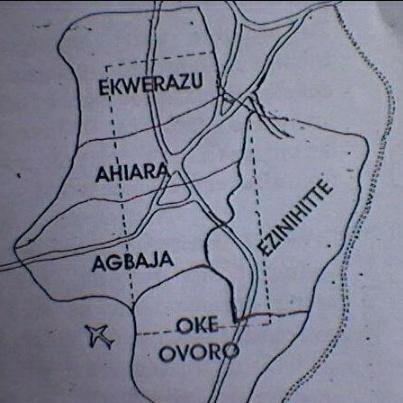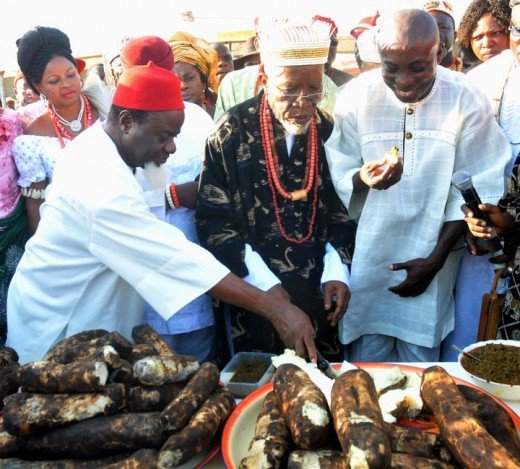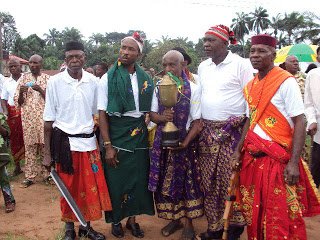The Iri-Ji Mbaise Festival Igbo-Tales
“Ahiajoku, anyi n’ekele gi!
Ahiajoku umu gi ekele gi!!
Lekwa ji nke ohuru umu gi wetere!!
Biko gozie ya k’anyi rie ya n’udo
Isee!!!”
This was what came to my mind as I tried to imagine how the Iri-Ji Ohuru festival was celebrated previously in the past. Most probably, the chief priest or the custodian of the tradition of the people would be the one saying the words above, while pouring out libation to the gods of the earth and harvest.
Who are the Mbaise people?

Source: The five Regions from which Mbaise got its name
Fondly called Country 5 by friends and well-wishers, Mbaise derived its name from five different cities which make up the region. These regions include Agbaja, Ahiara, Ekwerazu, Ezi na Ihite & Oke Ovuru. However, there are three major LGA’s that make up the Mbaise nation and these are Aboh Mbaise, Ahiazu Mbaise and Ezinihitte Mbaise. In terms of religion, a large percentage of Mbaise people are Catholics and a great number of Catholic priests have also been produced from this region. Inspite of this, the people still hold on to some of their former traditions and cultures which have now been repackaged to show a Christian face i.e. the Iri-Ji Mbaise.
The Ancient Iri-Ji Mbaise Festival
With modernity came some changes in the way the festival was previously practiced. At that time, Ahiajoku was seen and highly revered as the god of crops especially yam. Thus, whenever it was the harvesting season of the new yam, there would be no eating of the harvested yams until praise, thanksgiving and libation had been given to the yam god. Also, every household at that time had a shrine for the yam god where they offered their sacrifices of animals, drinks and food to Ahiajoku.
Myth about the Iri-Ji Mbaise Festival

Source: The Ahiajoku Myth
One of the most popular myths about the new yam festival has it that in ancient times, a man named Igbo and his children lived in abject hunger due to the famine ravaging the land. The gods then told Igbo to sacrifice his son, Ahiajoku as well as his daughter, Ada if he wanted to save his other children and wife from famine. After much sorrowful deliberations and thinking, he did as he was told. The bodies of his two children were cut into pieces and buried in different mounds. A few days later, yams sprouted out of the flesh of Ahiajoku while cocoyam began to grow from the mounds where Ada’s flesh were buried. Thus, Ahiajoku became known and worshipped as the god of yam.
The Modern Iri-Ji Festival

Source: The Eze cutting the New Yam
In today’s Mbaise, the Iri-Ji Mbaise Festival is celebrated on the 15th of August of every year. However, unlike in the past, the Festival has taken a new dimension. With the advent of Christianity, the festival now has a new face. Instead of sacrifices to Ahiajoku, praise and thanksgiving is now given to God Almighty for providing us with bountiful harvests.

Source: Inspection of the New Yams
Some activities of the day includes presentation of kolanuts, inspection of yam barns, dances, wrestling and masquerades. The climax of this festivity is the point where the Igwe or the oldest man in the community is invited to be the first to take a bite of the new yam. This yam is usually roasted and served with palm oil and different herbs. After he has taken, the yams can now be eaten by every other persons present.

Source: Costumes for the Ekpe Dance
The festival later comes to an end with joy, happiness and smiles on the faces of guests and spectators. Friends and well-wishers are always invited to the festival and they go back home with gladness.
This post has received a 3.12% upvote from @lovejuice thanks to @curtwriter. They love you, so does Aggroed. Please be sure to vote for Witnesses at https://steemit.com/~witnesses.
Thank you @lovejuice... You are always reliable
@cwen.... Here's my entry for the Igbo Tales contest.
This is really great work
Thanks boss